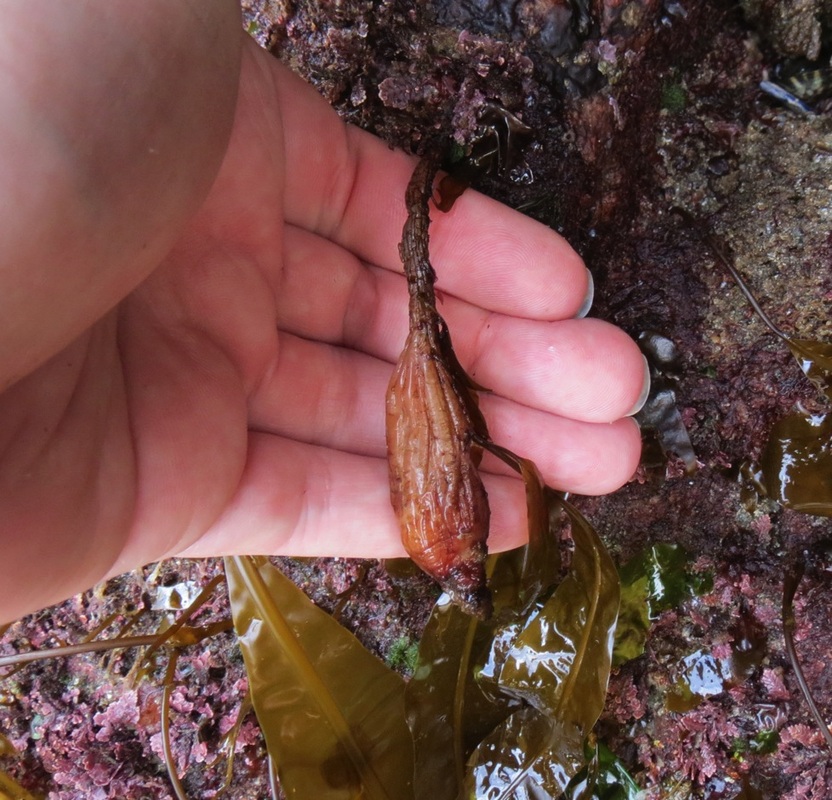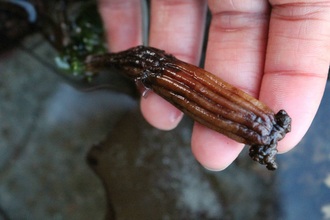Monterey stalked tunicate, Monterey stalked sea squirt, stalked tunicate • Styela montereyensis
Identification
The Monterey stalked tunicate is a soft-bodied animal with two siphons at one end. It is solitary and can reach a total size of 25 cm tall. Note the long, thin body and that one siphon is straight, while the other siphon is curved. It ranges in colour from orange-red to brown. Other organisms such as hydroids may grow upon it, which gives the tunicate a fuzzy appearance.
Habitat & Range
Look on docks, pilings with a good current, and exposed intertidal zones to 30 m depth. Its range extends from British Columbia to Baja, California.
Similar Species
The club tunicate (Styela barnharti) appears to be a shorter, wider version of the Monterey stalked tunicate. The club tunicate is an exotic species recently introduced to British Columbian waters near southern Vancouver Island. It is originally from the western Pacific Ocean, and was likely was introduced via the hulls of visiting ships.
Intriguing Info
Tunicates are suspension feeders that use their siphons to filter food particles from the water column. A high flow environment is needed for enough food to be captured. This is why although the Monterey Stalked Sea Tunicate looks fragile, it is found in high energy, pounding surf habitats along the coast.
The Monterey stalked tunicate is a soft-bodied animal with two siphons at one end. It is solitary and can reach a total size of 25 cm tall. Note the long, thin body and that one siphon is straight, while the other siphon is curved. It ranges in colour from orange-red to brown. Other organisms such as hydroids may grow upon it, which gives the tunicate a fuzzy appearance.
Habitat & Range
Look on docks, pilings with a good current, and exposed intertidal zones to 30 m depth. Its range extends from British Columbia to Baja, California.
Similar Species
The club tunicate (Styela barnharti) appears to be a shorter, wider version of the Monterey stalked tunicate. The club tunicate is an exotic species recently introduced to British Columbian waters near southern Vancouver Island. It is originally from the western Pacific Ocean, and was likely was introduced via the hulls of visiting ships.
Intriguing Info
Tunicates are suspension feeders that use their siphons to filter food particles from the water column. A high flow environment is needed for enough food to be captured. This is why although the Monterey Stalked Sea Tunicate looks fragile, it is found in high energy, pounding surf habitats along the coast.
References
Harbo, R. 2011. Whelks to Whales: Coastal marine life of the Pacific Northwest. Madeira Park, BC: Harbour Publishing. Pp. 194, 196.
Lamb, A., & Hanby, B. 2005. Marine Life of the Pacific Northwest: A photographic encyclopedia of invertebrates, seaweeds, and selected fishes. Madeira Park, BC: Harbour Publishing. P. 349.
Stalked Tunicate (Styela montereyensis). The Oregon Coast Aquarium. Accessed 26/6/2014.
Authors and editors of page
Christina Meschkat, Kelly Fretwell, and Brian Starzomski (2014).
Harbo, R. 2011. Whelks to Whales: Coastal marine life of the Pacific Northwest. Madeira Park, BC: Harbour Publishing. Pp. 194, 196.
Lamb, A., & Hanby, B. 2005. Marine Life of the Pacific Northwest: A photographic encyclopedia of invertebrates, seaweeds, and selected fishes. Madeira Park, BC: Harbour Publishing. P. 349.
Stalked Tunicate (Styela montereyensis). The Oregon Coast Aquarium. Accessed 26/6/2014.
Authors and editors of page
Christina Meschkat, Kelly Fretwell, and Brian Starzomski (2014).






